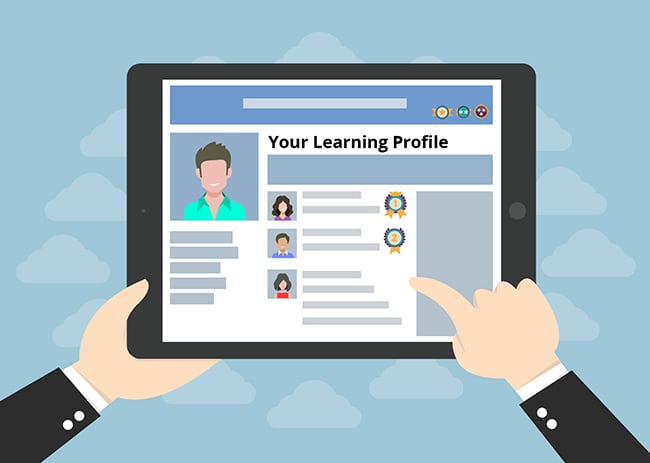Blog
3 e-Learning Design Steps to Avoid a Technical vs. Soft Skills Showdown
by Nicole Mellas, Instructional Designer A lot of online training is pretty boring and content-centric. If you’ve spent any time reading this blog ...


Social Media in e-Learning: Waste of Time, Magic Bullet, or Something In Between?
By Nicole Mellas | November 06, 2014 | Custom Learning | 0 Comments
 A lot of online training is pretty boring and content-centric.
A lot of online training is pretty boring and content-centric.
If you’ve spent any time reading this blog (or even perusing the blog titles), you probably won’t find this statement to be all that earth shattering. (If you do find it to be earth shattering, oh boy are you in for some surprises on this site!) Now, I’m not going to spend my time today writing another blog about what a shame it is that so much training lacks focus on the learner. I’m not going to ask you to read more about how successful e-learning employs contextualized challenges with rich feedback to create an experience that is meaningful, memorable, and motivational (though that DOES bear repeating, it’s not what I’m writing about today).
Let’s just accept, for a moment, that certain clients or stakeholders or subject matter experts insist upon paragraph after paragraph of “important” content on-screen. Let’s just accept, for a moment, that this often puts the beleaguered e-learning professional in the position of having to offer up a solution that is more page-turner than engaging instructional experience. What I find fascinating is that usually at this point, the same people who were clamoring for more and more and more content now lament, “This is boring. Nobody’s going to want to read this."
Yup.
Spoiler alert: if you’re hoping this blog is about to give you the answer as to how you can just sprinkle a few gaming elements or Twitter like Tweets on top of a page turner to transform it into engaging e-learning, you’re about to be disappointed. That’s not how gamification works. That’s not how integrating components of social media works. These are both immensely helpful strategies for serious e-learning when they are just that: strategies, conceived of as integral to the design process from day 1 (or at least day 2).
We already have a few excellent blog posts discussing how to add game-like qualities effectively when it comes to instructional design (I suggest starting here and here). So, in the spirit of adding to this conversation, I’d like to share a few ideas on how to effectively integrate social media components into the training experience.
I think social media components are most effectively used in training when the learner population is fairly widespread. Perhaps there are a lot of remote employees. Or perhaps employees work in an office environment, but are expected to collaborate with colleagues at any number of satellite locations. When I hear stuff like this about the intended audience, that immediately gets my social media wheels turning. Social media could mean getting creative with existing technologies (like private Facebook groups). Or, for larger scale products, it may mean creating a custom dashboard solution. Either way, designing (from the ground up) with social media strategies in mind can overcome some important challenges when it comes to engaging remote or widespread employees. Here are my tips!

Overcoming Challenges to Motivation with Social Media Components:
Overcoming Challenges to Efficient Communication with Social Media Components
Those are just a couple of ways that you might use social media strategy to build engagement and strengthen the entire training experience by creating not just isolated events but an entire culture of improvement! Again, these social media components are only as useful as the training they are designed to support. So all that good stuff about contextualized challenges and rich feedback? Yeah. That still applies. But hopefully this will give you a few ideas to bring to the table at the BEGINNING of a project (before you hear those dreaded words: “Let’s just add in some social media!”).
What about you? What social media components have you successfully integrated into your design? Or what are you dreaming about trying? Leave a comment and let us know!
Want to share this post? Here are some ready made tweets:
Click to Tweet: Learn 5 ways to overcome challenges by incorporating social components into your #elearning! http://hubs.ly/y0gZfv0
Click to Tweet: Use components of #socialmedia to help motivate learners and communicate effectively! http://hubs.ly/y0gZfv0 #elearning #learnermotivation
Click to Tweet: Leaderboards, Wikis & Discussion Boards, Oh My! 5 Ways to Use Social Media Components in Your #eLearning! http://hubs.ly/y0gZfv0 #lrnchat

About the Author: Nicole Mellas
Comments
Would you like to leave a comment?
Related Blog Posts

By: Nicole Mellas | Nov, 2015
Category: Custom Learning
.png?width=316&name=mellas%2c_nicole(200).png)
Blog
3 Steps to Get MORE out of Subject Matter Expert (SME) Interviews
by Nicole Mellas, Instructional Designer A lot of online training is pretty boring and content-centric. If you’ve spent any time reading this blog ...
By: Nicole Mellas | Mar, 2014
Category: Custom Learning

Blog
Beyond Liking It: Ask These 3 Learner-Centric Design Questions
by Nicole Mellas, Instructional Designer A lot of online training is pretty boring and content-centric. If you’ve spent any time reading this blog ...
By: Nicole Mellas | Mar, 2015
Category: Custom Learning

